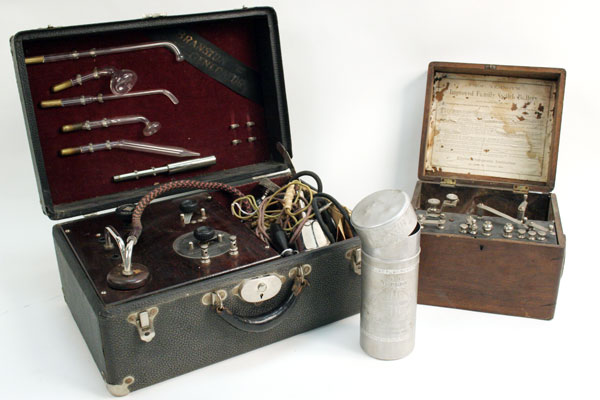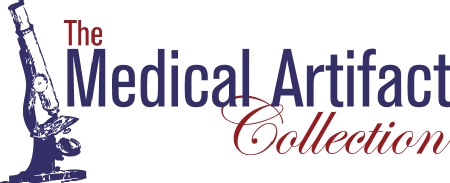In Canada, electrotherapy – or the use of electricity to treat illness or restore health – was practiced by doctors, lay practitioners and the general public from about the 1840s until the 1940s. Its popularity arose in part due to the simplicity and affordable cost of these devices as well as the ease in which individuals could administer treatment in homes, offices or hospitals. Moreover, these devices claimed to treat a wide range of aches, pains and ailments. How did these devices work? Nineteenth century devices such as Electromagnetic Machines, Faradic Battery Machines, and Galvanic Machines, among others, relied mostly on batteries. Some produced electricity through simple chemical action while others used magneto-electric power. For greater charge intensity, some portable devices used both a battery and an induction coil. Around the 1920s, a new device – the Ultra-Violet Ray Machine – became popular for home use. Through evacuated glass tubes, these machines emitted ultra-violet rays when an electrical charge passed through them. Various other “self-help” devices were also marketed in this period, including the “Theronoid” electromagnetic belt. By the 1930s and 1940s, electrotherapeutics had declied as a medical therapy due to its over-commercialization as a cure-all remedy. After completing this module students will understand: For each object answer the following questions: Branston Violet Ray High Frequency Generator and Ozone and Sinusoidal Controller database entry Duplex Oxypathor database entry Prof. Vernoy's Improved Family Switch Battery database entry Step 2: The Meaning of an Artifact For each object answer the following questions: The Vernoy Electro-Medical Battery advertisement, Toronto Star, 23 June 1905, 46, column 1 Obituary. Prof. S. Vernoy, Toronto Daily Star, 31 December 1904, 15, column 4 Magnus J. Redding. Aids to Electro-therapeutics (Toronto: Macmillan Co., 1920), 1-6. Branston electrotherapy machine advertisement, Globe and Mail, Toronto, 14 October 1918, 5. Richard Kovacs, Electrotherapy and the Elements of Light Therapy (Philadelphia: Lea & Febiger, 1932), 90-98, 310-17. O.M. Justice, M.D., Ozone Therapy (Hollywood, 1951). Betzco catalogue for physicians Morris Fishbein, Fads and Quackery in Healing: an Analysis fo the Foibles of the Healing Cults, with Essays on Various other Peculiar Notions in the Health Field. (New York: Covici, Friede, 1932), 290-301. American Medical Association, "Electropoise-Oxydonor-Oxygenor-Oxypathor-Oxytonor-Oxybon,” Nostrums and Quackery, Articles on the Nostrum Evil and Quackery Repreinted from the Journal of the American Medical Association (Chicago: Press of American Medical Association, 1911), 295-309. (PDF 1.8 MB) Primary Sources American Medical Association. Nostrums and Quackery: Articles on the Nostrum Evil and Quackery Reprinted from the Journal of the American Medical Association. Chicago: Press of American Medical Association, 1911. Beard, George Miller. Practical Treatise on Nervous Exhaustion (Neurasthenia). New York: Kraus Reprint, 1971. Cruikshank, Omar T. Electro-therapy in the Abstract for the Busy Practitioner. Philadelphia: The Dando Company, 1917. Fishbein, Morris. Fads and Quackery in Healing: an Analysis of the Foibles of the Healing Cults, with Essays on Various other Peculiar Notions in the Health Field. New York: Covici, Friede, 1932. Garratt, Alfred Charles. Electro-physiology and Electro-therapeutics; Showing the Best Methods for the Medical Uses of Electricity. Boston: Ticknor and Fields, 1860. Grover, Burton. Handbook of Electrotherapy for Practitioners and Students. Philadelphia: F. A. Davis Company, 1926. Guilleminot, W. H. Handbook of Electricity in Medicine. New York: London, Rebman Company, 1906. Kovacs, Richard. Electrotherapy and the Elements of Light Therapy. Philadelphia: Lea & Febiger, 1932. Massey, George Betton. Conservative Gynecology and Electro-therapeutics: a Practical Treatise on the Diseases of Women and their Treatment by Electricity. Philadelphia: F. A. Davis Company, 1905. Neiswanger, Charles Sherwood. Electro-therapeutical Practice; a Ready Reference Guide for Physicians in the Use of Electricity. Chicago: Ritchie and Company, 1912. Palmer, H. On the Application of Localised Galvanism in the Treatment of Disease. Toronto: Blackburn's City Steam Press, 1863. Redding, J. Magnus. Aids to Electro-therapeutics. Toronto: Macmillan Co., 1920. Rice, May Cushman. Electricity in Gynecology: the Practical Uses of Electricity in Diseases of Women. Chicago: L. I. Laing and Co., 1912. Webster, John Clarence. Diseases of Women: a Text-Book for Students and Practitioners. Edinburgh: Y.J. Pentland, 1898. Secondary Sources Connor, J. T. H. “Medical Technology in Victorian Canada.” Canadian Bulletin of Medical History 3, 1 (1986): 97-123. Connor, J. T. H. and Felicity Pope. “A Shocking Business: The Technology and Practice of Electrotherapeutics in Canada, 1840s to 1940s.” Material History Review 49 (1999): 60-70. De La Pena, Carolyn Thomas. The Body Electric: How Strange Machines Build the Modern American. New York: New York University Press, 2003. Greenway, John L. “‘Nervous Disease:’ and Electric Medicine.” In Pseudo-Science and Society in Nineteenth-Century America. Ed. Arthur Wrobel. Pp. 46-73. Lexington: University Press of Kentucky, 1987. Longo, Lawrence. “Electrotherapy in Gynecology: The American Experience.” Bulletin of the History of Medicine 60, 3 (1986): 343-66. Maines, Rachel P. The Technology of Orgasm: “Hysteria,” the Vibrator, and Women's Sexual Satisfaction. Baltimore: Johns Hopkins University Press, 1999. Rosner, Lisa. “The Professional Context of Electrotherapeutics.” Journal of the History of Medicine and Allied Sciences 43, 1 (1988): 64-82. Rowbottom, Margaret and Charles Susskind. Electricity and Medicine: A History of their Interaction. San Francisco: San Francisco Press, Inc., 1984. Young, James Harvey. American Health Quackery: Collected Essays. Princeton: Princeton University Press, 1992.
Learning Objectives
Step 1: The Objects and Their Properties
Alternative Images
180° View (requires QuickTime) (1.2Mb)
Directions for the Branston Violet Ray Machine
Alternative Images
Duplex Oxypathor Instructions
Alternative Images
Oxypathor advertisement, Globe and Mail, Toronto, 2 September 1911, 5.
Oxypathor advertisement, Globe and Mail, Toronto, 20 January 1912, 4.Selected References for Further Research
Cumberbatch, Elkin. Essentials of Medical Electricity. St. Louis, C. V. Mosby Co., 1924.
You are using a browser that is not standards-compliant. The information on this Web site will be accessible to you, but for a list of Web browsers that comply with the World Wide Web Consortium standards, please visit our Web standards page.

